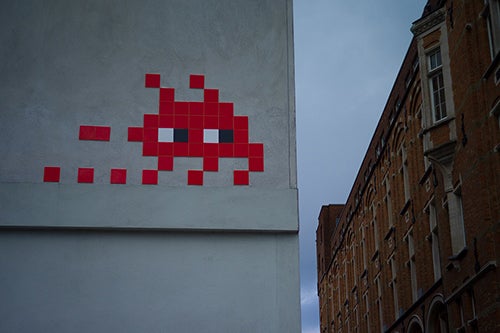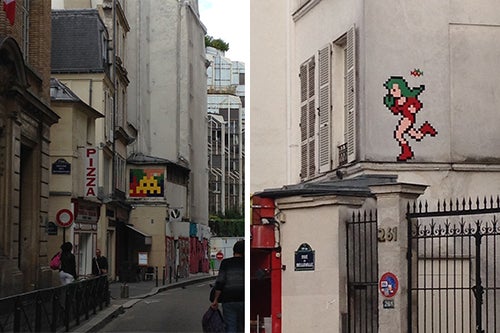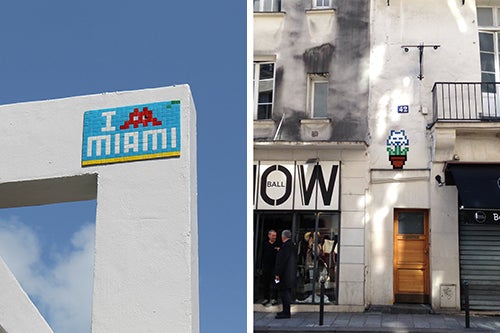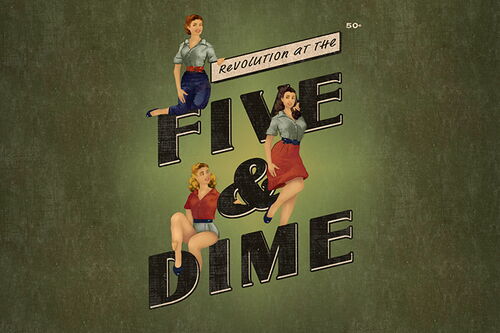Space Invaders and the modern age

What happens when urban art becomes literally a global invasion? That’s the question addressed by Julie Gaillard, professor of French, who has been tracking the work and significance of a secretive, anonymous artist who has created pixelated characters from a 1970s video game and placed them around the world—and even beyond this world.
“What started as an urban art practice indeed evolved into a more global invasion project over time,” said Gaillard, whose recent article, “Returning ‘Home’? Or Dwelling in the Pixel Age: On Invader’s Intermedial Space Invasion,” explores the work of Invader, a French contemporary artist who combines mosaics with pixel art.
“He is most famous for his appropriation and re-mediation of the little characters from the iconic arcade game Space Invaders,” Gaillard explained. The goal of Space Invaders, created in 1978 by Taito, is to prevent aliens from reaching Earth. Invader’s art largely resembles the aliens.

“Invader, on the contrary, invades urban space with these characters, finding in mosaic tiles the perfect material to replicate the aesthetics of pixels,” Gaillard said.
The result? Thousands of pixelated tile images of space invader characters placed on walls and posts and other structures everywhere from Paris to Istanbul, New York, Seoul, and Varanasi, India. They’re in the Tanzanian Savannah, the mountains of Bhutan, and one is even undersea in the Bay of Cancún. With some help he even got a small one into the International Space Station (represented by a moving, orbiting icon on an online world map where artist shows the location of his work).
“These iconic pixel effigies are a symbol for the global upheaval brought about by digital technologies,” Gaillard said.
Invader placed the first pilot space invader in Paris in 1996, and since then he has placed more than 4,100 space invaders in 83 cities over five continents. Gaillard encountered them for the first time in Paris, which seems to be their home base—there exist almost 1,500 in the French city.

“Interestingly, while Invader’s urban invasion entails many similarities with the practice of graffiti—its illegality, its virality, its way of reclaiming a space ‘from below’—his practice is also radically anonymous,” she noted.
To secure his anonymity, Invader largely works at night. Other times he dons some form of disguise, typically by wearing a mask. In fact, the artist claims very few people actually know his true identity. It is even reported that his parents believe he is simply a tiler in the construction industry.
Through her research Gaillard has established that the pace of the artist’s invasions reflect the speed of digital technology’s transformations.
“Invader was born at the end of the 1960s. He belongs to a generation who grew up playing eight-bits videogames and witnessed the democratization of personal computers,” she said. “Since he started in the late 1990s, his world invasion project has evolved to embrace new technologies—for instance, the invention of the smartphone.”
Invader experimented with QR codes and in 2014 developed the game Flash Invaders, an app where players can flash space invaders they find in the streets, earn points, and compete with a global community.

“By bringing together pixel, mosaic, graffiti and game, Invader invites viewers to reflect on the impact of digital technologies on the ways humans relate to space, time, and each other,” Gaillard said.
She added: “What may seem at first like a geeky or superficial nostalgic revival of 70s pop culture actually engages in a deep and meaningful dialogue with art history and invites viewers-players to reflect on how these transformations, which occurred so fast, have affected humans’ ways of dwelling in the world.”
Earlier this year, Gaillard’s publication on Invader’s work received a research prize from the Humanities Research Institute at U of I. In 2020 she also wrote a book, “Réalités pseudonymes,” exploring how reality is constituted through the lens of proper names and their referential mechanisms across literature, photography, performance, and urban art. Invader’s World invasion project is in the book.
Invader’s project, as she puts it, creates “a playful, anonymous space of resistance, that works against the stability of bourgeois identities, the commodification of human sociability, and the regulation of human existence through algorithms and mass surveillance.”
Gaillard is currently working on two new articles that focus on issues of dwelling and public space at the intersection of aesthetics and cultural studies. In the meantime, you can keep up to date with Invader and the space invaders here.








